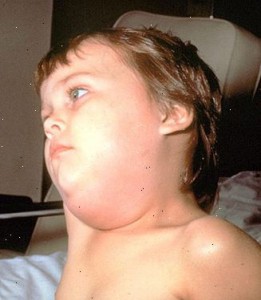Ludwig’s Angina
Patient with an infectious process located at the floor of the mouth, always consider a Ludwig’s angina. This is cellulitis of the submandibular and sublingual regions, caused in 70% of cases an infection spreading from the second or third lower molars. Patients usually complain of dental and neck pain or odynophagia. We will especially pay attention to induration of the mouth floor and elevated tongue. Sometimes the inflammation has spread to the masticatory muscle, creating a lockjaw that limits the examination of the oral cavity.
The treatment of Ludwig’s angina contains three aspects that must be considered in a chronological order:
- The key is to ensure the integrity of the upper respiratory tract.
- Secondly, intravenous antibiotic therapy with high-dose penicillin and beta-lactamase inhibitor, such as cephalosporin or clindamycin should be undertaken.
- Finally, drainage must be considered when clinical examination or imaging highlights a collection of pus or infected areas or when decompression is necessary in the absence of response to intravenous antibiotic treatment.

Reference: Le Médecin du Québec, Volume 42, Number 5, May 2007.
__________________________
Emergency in ENT
Peritonsillar abscess
Ludwig’s Angina
Foreign body in the ear
Foreign body in the respiratory tract (nose, trachea, bronchi)
Foreign body in the esophagus
Epiglottitis
Epistaxis
Perilymphatic fistula
Nose fracture
Hemorrhage post-adenotonsillectomy
Acute mastoiditis
Facial paralysis
Sudden hearing loss
